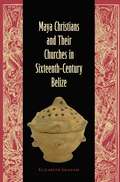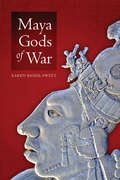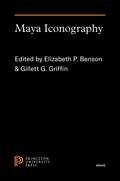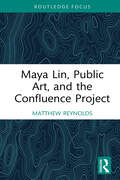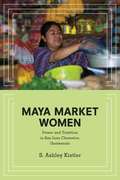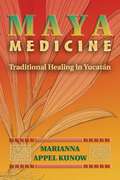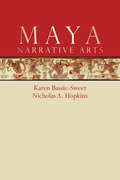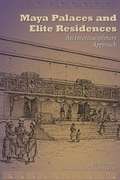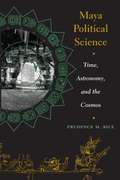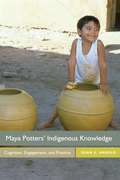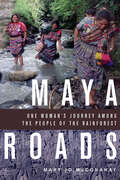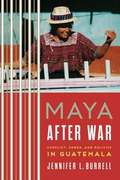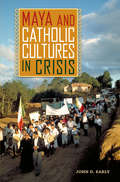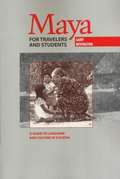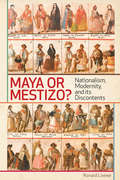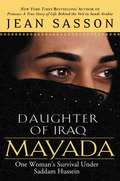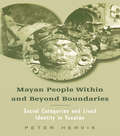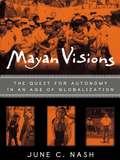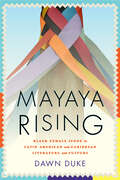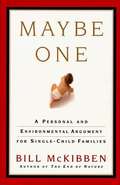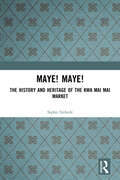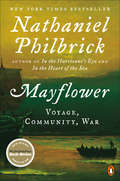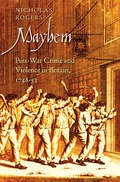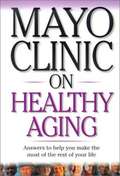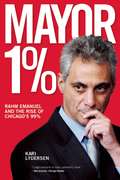- Table View
- List View
Maya Christians and Their Churches in Sixteenth-Century Belize: Maya Christians And Their Churches In Sixteenth-century Belize (Maya Studies)
by Elizabeth Graham"An important and innovative study that brings a good number of fascinating archaeological findings to bear on the process of Christian conversion in the colonial Maya world. Seldom has the archaeological material culture of an evangelized society been brought to light so thoroughly and engagingly."—Fernando Cervantes, coauthor of Angels, Demons, and the New World"A convincing and fascinating study of Maya religion and Christianity in the frontier."—Joel Palka, University of Illinois-ChicagoBased on her analysis of archaeological evidence from the excavations of Maya churches at Tipu and Lamanai, Elizabeth Graham seeks to understand why the Maya sometimes actively embraced Catholicism during the period of European conquest and continued to worship in this way even after the end of Spanish occupation.The Maya in Belize appear to have continued to bury their dead in Christian churchyards long after the churches themselves had fallen into disuse. They also seem to have hidden pre-Hispanic objects of worship in Christian sacred spaces during times of persecution, and excavations reveal the style of the early churches to be unmistakably Franciscan. The evidence suggests that the Maya remained Christian after 1700, when Spaniards were no longer in control, which challenges the widespread assumption that because Christianity was imposed by force it was never properly assimilated by indigenous peoples.Combining historical and archaeological data with her experience of having been raised as a Roman Catholic, Graham proposes a way of assessing the concept of religious experience and processes of conversion that takes into account the material, visual, sensual, and even olfactory manifestations of the sacred.Elizabeth Graham is senior lecturer of Mesoamerican archaeology at University College London.
Maya Gods of War
by Karen Bassie-SweetNumerous archaeological projects have found substantial evidence of the military nature of Maya society, and warfare is a frequent theme of Maya art. Maya Gods of War investigates the Classic period Maya gods who were associated with weapons of war and the flint and obsidian from which those weapons were made. Author Karen Bassie-Sweet traces the semantic markers used to distinguish flint from other types of stone, surveys various types of Chahk thunderbolt deities and their relationship to flint weapons, and explores the connection between lightning and the ruling elite. Additional chapters review these fire and solar deities and their roles in Maya warfare and examine the nature and manifestations of the Central Mexican thunderbolt god Tlaloc, his incorporation into the Maya pantheon, and his identification with meteors and obsidian weapons. Finally, Bassie-Sweet addresses the characteristics of the deity God L, his role as an obsidian merchant god, and his close association with the ancient land route between the highland Guatemalan obsidian sources and the lowlands. Through analysis of the nature of the Teotihuacán deities and exploration of the ways in which these gods were introduced into the Maya region and incorporated into the Maya worldview, Maya Gods of War offers new insights into the relationship between warfare and religious beliefs in Mesoamerica. This significant work will be of interest to scholars of Maya religion and iconography.
Maya Iconography
by Elizabeth P. Benson Gillett G. GriffinA landmark work on the iconography of one of the world&’s great civilizationsThis book presents foundational work on Maya iconography from leading practitioners in fields ranging from archaeology, anthropology, and art history to linguistics, astronomy, photography, and medicine. The period discussed runs from the last centuries B.C. through the great Maya Classic period, with some discussion of later eras and of regions outside the Maya area. Featuring an incisive introduction by Elizabeth Benson and Gillett Griffin, Maya Iconography demonstrates how Maya beliefs developed over time and makes important connections between Preclassic and Classic iconography.The contributors are John Carlson, Michael Coe, David Freidel, Donald Hales, Norman Hammond, Nicholas Hellmuth, John Justeson, Barbara Kerr, Justin Kerr, Mary Ellen Miller, William Norman, Lee Parsons, Francis Robicsek, Linda Schele, David Stuart, and Karl Taube.
Maya Lin, Public Art, and the Confluence Project (Routledge Focus on Art History and Visual Studies)
by Matthew ReynoldsThe first scholarly monograph devoted exclusively to this vital work of contemporary public art, this book examines Maya Lin’s Confluence Project through the lens of environmental humanities and Indigenous studies. Matthew Reynolds provides a detailed analysis of each earthwork, along with a discussion of the proposed final project at Celilo Falls near The Dalles, Oregon. The book assesses the artist’s longtime engagement with the region of the Pacific Northwest and explores the Confluence Project within Lin’s larger oeuvre. Several consistent themes and experiences are common amongst all the sites. These include an emphasis on individual, multisensory encounters with the earthworks and their surrounding contexts; sound as an experiential dimension of landscape; indexical accounts of the multicultural, multispecies histories of each place; and an evocation of loss. The book will be of interest to scholars working in art history, contemporary art, environmental studies, environmental humanities, and Native American studies.
Maya Market Women: Power and Tradition in San Juan Chamelco, Guatemala (Interpretations of Culture in the New Millennium)
by S. Ashley KistlerAs cultural mediators, Chamelco's market women offer a model of contemporary Q'eqchi' identity grounded in the strength of the Maya historical legacy. Guatemala's Maya communities have faced nearly five hundred years of constant challenges to their culture, from colonial oppression to the instability of violent military dictatorships and the advent of new global technologies. In spite of this history, the people of San Juan Chamelco, Guatemala, have effectively resisted significant changes to their cultural identities. Chamelco residents embrace new technologies, ideas, and resources to strengthen their indigenous identities and maintain Maya practice in the 21st century, a resilience that sets Chamelco apart from other Maya towns. Unlike the region's other indigenous women, Chamelco's Q'eqchi' market women achieve both prominence and visibility as vendors, dominating social domains from religion to local politics. These women honor their families' legacies through continuation of the inherited, high-status marketing trade. In Maya Market Women, S. Ashley Kistler describes how market women gain social standing as mediators of sometimes conflicting realities, harnessing the forces of global capitalism to revitalize Chamelco's indigenous identity. Working at the intersections of globalization, kinship, gender, and memory, Kistler presents a firsthand look at Maya markets as a domain in which the values of capitalism and indigenous communities meet.
Maya Medicine: Traditional Healing in Yucatán
by Marianna Appel KunowThis account of the practice of traditional Maya medicine examines the work of curers in Pisté, Mexico, a small town in the Yucatán Peninsula near the ruins of Chichén Itzá. The traditions of plant use and ethnomedicine applied by these healers have been transmitted from one generation to the next since the colonial period throughout the state of Yucatán and the adjoining states of Campeche and Quintana Roo.In addition to plants, traditional healers use western medicine and traditional rituals that include magical elements, for curing in Yucatán is at once deeply spiritual and empirically oriented, addressing problems of the body, spirit, and mind. Curers either learn from elders or are recruited through revelatory dreams. The men who learn their skills through dreams communicate with supernatural beings by means of divining stones and crystals. Some of the locals acknowledge their medical skills; some disparage them as rustics or vilify them as witches. The curer may act as a doctor, priest, and psychiatrist.This book traces the entire process of curing. The author collected plants with traditional healers and observed their techniques including prayer and massage as well as plant medicine, western medicine, and ritual practices. Plant medicine, she found, was the common denominator, and her book includes information on the plants she worked with and studied.
Maya Narrative Arts
by Karen Bassie-Sweet Nicholas A. HopkinsIn Maya Narrative Arts, authors Karen Bassie-Sweet and Nicholas A. Hopkins present a comprehensive and innovative analysis of the principles of Classic Maya narrative arts and apply those principles to some of the major monuments of the site of Palenque. They demonstrate a recent methodological shift in the examination of art and inscriptions away from minute technical issues and toward the poetics and narratives of texts and the relationship between texts and images. Bassie-Sweet and Hopkins show that both visual and verbal media present carefully planned narratives, and that the two are intimately related in the composition of Classic Maya monuments. Text and image interaction is discussed through examples of stelae, wall panels, lintels, benches, and miscellaneous artifacts including ceramic vessels and codices. Bassie-Sweet and Hopkins consider the principles of contrast and complementarity that underlie narrative structures and place this study in the context of earlier work, proposing a new paradigm for Maya epigraphy. They also address the narrative organization of texts and images as manifested in selected hieroglyphic inscriptions and the accompanying illustrations, stressing the interplay between the two. Arguing for a more holistic approach to Classic Maya art and literature, Maya Narrative Arts reveals how close observation and reading can be equally if not more productive than theoretical discussions, which too often stray from the very data that they attempt to elucidate. The book will be significant for Mesoamerican art historians, epigraphers, linguists, and archaeologists.
Maya Palaces and Elite Residences: An Interdisciplinary Approach
by Jessica Joyce ChristieMaya "palaces" have intrigued students of this ancient Mesoamerican culture since the early twentieth century, when scholars first applied the term "palace" to multi-room, gallery-like buildings set on low platforms in the centers of Maya cities. Who lived in these palaces? What types of ceremonial and residential activities took place there? How do the physical forms and spatial arrangement of the buildings embody Maya concepts of social organization and cosmology? This book brings together state-of-the-art data and analysis regarding the occupants, ritual and residential uses, and social and cosmological meanings of Maya palaces and elite residences. A multidisciplinary team of senior researchers reports on sites in Belize (Blue Creek), Western Honduras (Copan), the Peten (Tikal, Dos Pilas, Aguateca), and the Yucatan (Uxmal, Chichen-Itza, Dzibilchaltun, Yaxuna). Archaeologist contributors discuss the form of palace buildings and associated artifacts, their location within the city, and how some palaces related to landscape features. Their approach is complemented by art historical analyses of architectural sculpture, epigraphy, and ethnography. Jessica Joyce Christie concludes the volume by identifying patterns and commonalties that apply not only to the cited examples, but also to Maya architecture in general.
Maya Political Science: Time, Astronomy, and the Cosmos
by Prudence M. RiceHow did the ancient Maya rule their world? Despite more than a century of archaeological investigation and glyphic decipherment, the nature of Maya political organization and political geography has remained an open question.<P><P> Many debates have raged over models of centralization versus decentralization, superordinate and subordinate status--with far-flung analogies to emerging states in Europe, Asia, and Africa. But Prudence Rice asserts that neither the model of two giant "superpowers" nor that which postulates scores of small, weakly independent polities fits the accumulating body of material and cultural evidence.
Maya Potters' Indigenous Knowledge: Cognition, Engagement, and Practice
by Dean E. ArnoldBased on fieldwork and reflection over a period of almost fifty years, Maya Potters’ Indigenous Knowledge utilizes engagement theory to describe the indigenous knowledge of traditional Maya potters in Ticul, Yucatán, Mexico. In this heavily illustrated narrative account, Dean E. Arnold examines craftspeople’s knowledge and skills, their engagement with their natural and social environments, the raw materials they use for their craft, and their process for making pottery. Following Lambros Malafouris, Tim Ingold, and Colin Renfrew, Arnold argues that potters’ indigenous knowledge is not just in their minds but extends to their engagement with the environment, raw materials, and the pottery-making process itself and is recursively affected by visual and tactile feedback. Pottery is not just an expression of a mental template but also involves the interaction of cognitive categories, embodied muscular patterns, and the engagement of those categories and skills with the production process. Indigenous knowledge is thus a product of the interaction of mind and material, of mental categories and action, and of cognition and sensory engagement—the interaction of both human and material agency. Engagement theory has become an important theoretical approach and “indigenous knowledge” (as cultural heritage) is the focus of much current research in anthropology, archaeology, and cultural resource management. While Dean Arnold’s previous work has been significant in ceramic ethnoarchaeology, Maya Potters' Indigenous Knowledge goes further, providing new evidence and opening up different concepts and approaches to understanding practical processes. It will be of interest to a wide variety of researchers in Maya studies, material culture, material sciences, ceramic ecology, and ethnoarchaeology.
Maya Roads: One Woman's Journey Among the People of the Rainforest
by Mary Jo McconahayDrawing upon three decades of working, traveling, and living in Central America's remote and dangerous landscapes, this memoir chronicles a journalist's fascinating experiences with the people, politics, archaeology, and species of the rainforest, the cradle of Mayan civilization. The intense beauty of the forest, the fantastic locales, the ancient ruins, and the horrific violence of the jungle are brought to life through clear and compelling language. The author plays witness to archaeological discoveries, the transformation of the Lacandon people, the Zapatista indigenous uprising in Mexico, and increased drug trafficking, and she assists in the uncovering of a war crime. Great changes of the region, from a time when the jungle had virtually no roads and no visitors to the vacationers and adventure travelers who now arrive daily, are revealed in this unique exploration of the adaptation and resolve of a people.
Maya after War: Conflict, Power, and Politics in Guatemala
by Jennifer L. BurrellGuatemala’s thirty-six-year civil war culminated in peace accords in 1996, but the postwar transition has been marked by continued violence, including lynchings and the rise of gangs, as well as massive wage-labor exodus to the United States. For the Mam Maya municipality of Todos Santos Cuchumatán, inhabited by a predominantly indigenous peasant population, the aftermath of war and genocide resonates with a long-standing tension between state techniques of governance and ancient community-level power structures that incorporated concepts of kinship, gender, and generation. Showing the ways in which these complex histories are interlinked with wartime and enduring family/class conflicts, Maya after War provides a nuanced account of a unique transitional postwar situation, including the complex influence of neoliberal intervention. Drawing on ethnographic field research over a twenty-year period, Jennifer L. Burrell explores the after-war period in a locale where community struggles span culture, identity, and history. Investigating a range of tensions from the local to the international, Burrell employs unique methodologies, including mapmaking, history workshops, and an informal translation of a historic ethnography, to analyze the role of conflict in animating what matters to Todosanteros in their everyday lives and how the residents negotiate power. Examining the community-based divisions alongside national postwar contexts, Maya after War considers the aura of hope that surrounded the signing of the peace accords, and the subsequent doubt and waiting that have fueled unrest, encompassing generational conflicts. This study is a rich analysis of the multifaceted forces at work in the quest for peace, in Guatemala and beyond.
Maya and Catholic Cultures in Crisis
by John D. Early"A landmark achievement that will no doubt be cited again and again for years to come. It is a thoroughly-researched and authoritative work."--Allen J. Christenson, author of Art and Society in a Highland Maya Community "While this book explains what brought about the Maya uprisings in Chiapas and Guatemala and answers questions about the role of the Catholic Church in the development of the uprisings, the heart of the book is about the Mayan quest to live with dignity as Maya in the modern world."--Christine Gudorf, author of Catholic Social Teaching on Liberation Themes In his most recent book, The Maya and Catholicism: An Encounter of Worldviews, John Early examined the relationship between the Maya and the Catholic Church from the sixteenth century through the colonial and early national periods. In Maya and Catholic Cultures in Crisis, he returns to delve into the changing worldviews of these two groups in the second half of the twentieth century--a period of great turmoil for both. Drawing on his personal experiences as a graduate student, a Roman Catholic priest in the region and his extensive archival research, Early constructs detailed case histories of the Maya uprisings against the governments of Guatemala and Mexico, exploring Liberation Catholicism’s integral role in these rebellions as well as in the evolutions of Maya and Catholic theologies. His meticulous and insightful study is indispensable to understanding Maya politics, society, and religion in the late twentieth century. John D. Early, professor emeritus of anthropology at Florida Atlantic University, is the author of The Maya and Catholicism and coauthor of several books, including The Xilixana Yanomami of the Amazon.
Maya for Travelers and Students: A Guide to Language and Culture in Yucatan
by Gary BevingtonThe Yucatan Peninsula draws many North American and European travelers each year to view the ruins of the pre-Columbian Classical Maya civilization and the abundant native flora and fauna. For these travelers, as well as armchair travelers and students, Gary Bevington has prepared the first general English-language introduction to Yucatec Maya, the native language of the people indigenous to the region. Written in nontechnical terms for learners who have a basic knowledge of simple Mexican Spanish, the book presents easily understood, practical information for anyone who would like to communicate with the Maya in their native language. In addition to covering the pronunciation and grammar of Maya, Bevington includes invaluable tips on learning indigenous languages "in the field. " Most helpful are his discussions of the cultural and material worlds of the Maya, accompanied by essential words and expressions for common objects and experiences. A Maya-English-Spanish glossary with extensive usage examples and an English-Maya glossary conclude the book. Note: The supplemental audiocasette, Spoken Maya for Travelers and Students, is now available as a free download.
Maya or Mestizo?: Nationalism, Modernity, And Its Discontents
by Ronald LoeweThe Maya of the Yucatán have long been drawn into the Mexican state's attempt to create modern Mexican citizens (mestizos). At the same time, they have contended with globalization pressures, first with hemp production and more recently with increased tourism and the fast-growing influence of American-based evangelical Protestantism. Despite these pressures to turn Maya into mestizo, the citizens of the small town of Maxcanú have used subtle forms of resistance—humor, satire, and language—to maintain aspects of their traditional identity. Loewe offers a contemporary look at a Maya community caught between tradition and modernity. He skilfully weaves the history of Mexico and this particular community into the analysis, offering a unique understanding of how one local community has faced the onslaught of modernization.
Mayada, Daughter of Iraq: One Woman's Survival Under Saddam Hussein
by Jean SassonSasson paints an intimate portrait of one woman's incredible life under the regime of Saddam Hussein. Once a privileged member of Iraqi society, Mayada's life shifted drastically when she was thrown into the notorious Baladiayat Prison.
Mayan People Within and Beyond Boundaries: Social Categories and Lived Identity in the Yucatan (Studies In Anthropology And History Ser. #No.25.)
by Peter HervikMayan People Within and Beyond Boundaries explores the Maya of Yucatan, the Maya of academic institutions and the Maya of the tourist industry. It examines the interplay between the local and the external, academic categories of the Maya, and seeks to transcend the paradoxical and incongruent relationship between the social spaces that breathe life into the categories. The notion of "shared social experience" is introduced to embody a focus on reflexivity that goes beyond the subjective position of the author and helps demystify the coexisting subjectivities characteristic of ethnographic fieldwork. It provides a basis for overcoming the exclusive focus on "author," " text," and "discourse" in contemporary postmodernist ethnography, while still conveying important ethnographic information.
Mayan Visions: The Quest for Autonomy in an Age of Globalization
by June C. NashA significant work by one of anthropology's most important scholars, this book provides an introduction to the Chiapas Mayan community of Mexico, better known for their role in the Zapatista Rebellion.
Mayaya Rising: Black Female Icons in Latin American and Caribbean Literature and Culture
by Dawn DukeWho are the Black heroines of Latin America and the Caribbean? Where do we turn for models of transcendence among women of African ancestry in the region? In answer to the historical dearth of such exemplars, Mayaya Rising explores and celebrates the work of writers who intentionally center powerful female cultural archetypes. In this inventive analysis, Duke proposes three case studies and a corresponding womanist methodology through which to study and rediscover these figures. The musical Cuban-Dominican sisters and former slaves Teodora and Micaela Ginés inspired Aida Cartagena Portalatin’s epic poem Yania tierra; the Nicaraguan matriarch of the May Pole, “Miss Lizzie,” figures prominently in four anthologies from the country’s Bluefields region; and the iconic palenqueras of Cartagena, Columbia are magnified in the work of poets María Teresa Ramírez Neiva and Mirian Díaz Pérez. In elevating these figures and foregrounding these works, Duke restores and repairs the scholarly record.
Maybe One: A Personal and Environmental Argument for Single-Child Families
by Bill MckibbenFrom the ground breaking author of "The End of Nature" comes a provocative, compelling, and environmentally sound argument for saving the planet through voluntary population control.
Maye! Maye!: The History and Heritage of the Kwa Mai Mai Market
by Sipho SitholeThis book presents an analysis of Johannesburg’s Kwa Mai Mai market, which was once known to regulars as 'a place of healing' and has experienced numerous changes of significant national transformation over time. It explores how the Kwa Mai Mai community, formerly a working class of migrants, reversed roles and took control of the means of production from the dominant class. Through their heightened cultural consciousness, this marginalised migrant community reimagined new economic realities and possibilities, forever distancing themselves from their painful, repressive past. This book chronicles the significance of cultural memory and discusses how it can be used as a weapon to not only resist subjugation but also to invoke entrepreneurial and creative spirit.Written out of the collective observations and interpretations of his ethnographic research spanning four years – Sipho Sithole’s ‘Maye Maye’ is dedicated to marginalised communities and those who, despite operating on the fringes of the economy, have sought to create their own fortune and destiny.Print edition not for sale in Sub Saharan Africa.
Mayflower: A Story of Courage, Community, and War
by Nathaniel PhilbrickHow did America begin? That simple question launches the acclaimed author of Bunker Hill and Valiant Ambition on an extraordinary journey to understand the truth behind our most sacred national myth: the voyage of the Mayflower and the settlement of Plymouth Colony. As Philbrick reveals in this electrifying history of the Pilgrims, the story of Plymouth Colony was a fifty-five year epic that began in peril and ended in war. New England erupted into a bloody conflict that nearly wiped out the English colonists and natives alike. These events shaped the existing communities and the country that would grow from them.
Mayhem
by Nicholas RogersAfter the end of the War of Austrian Succession in 1748, thousands of unemployed and sometimes unemployable soldiers and seamen found themselves on the streets of London ready to roister the town and steal when necessary. In this fascinating book Nicholas Rogers explores the moral panic associated with this rapid demobilization.Through interlocking stories of duels, highway robberies, smuggling, riots, binge drinking, and even two earthquakes, Rogers captures the anxieties of a half-decade and assesses the social reforms contemporaries framed and imagined to deal with the crisis. He argues that in addressing these events, contemporaries not only endorsed the traditional sanction of public executions, but wrestled with the problem of expanding the parameters of government to include practices and institutions we now regard as commonplace: censuses, the regularization of marriage through uniform methods of registration, penitentiaries and police forces.
Mayo Clinic On Healthy Aging: Answers to Help You Make the Most of the Rest of Your Life
by Edward T. CreaganHealthy aging doesn't occur by accident. This book provides information you can use to successfully manage the aging process and maintain or improve the quality of your living. Inside you'll discover: *How to approach the aging process *How to deal with changes in the way your body looks and works *How to exercise safely and effectively *How to maintain a positive outlook on life *How to nurture your mind and spirit *How to manage your finances *How to secure high-quality health care *How to stay connected with family and friends *How to maintain your independence *How to know when you need help *How to secure help if you need it *Where to go for additional assistance.
Mayor 1%
by Kari LydersenHow did a city long dominated by a notorious Democratic Machine become a national battleground in the right-wing war against the public sector? In Mayor 1%, veteran journalist Kari Lydersen takes a close look at Chicago mayor Rahm Emanuel and his true agenda.With deep Wall Street ties from his investment banking years and a combative political style honed in Congress and the Clinton and Obama administrations, Emanuel is among a rising class of rock-star mayors promising to remake American cities.But his private-sector approach has sidelined and alienated many who feel they are not part of Emanuel's vision for a new Chicago-and it has inspired a powerful group of activists and community members to unite in defense of their beloved city.Kari Lydersen is a Chicago-based journalist, author and journalism instructor who has written for the Washington Post, the New York Times, the Progressive, In These Times, and other publications. She is the author of four books, including The Revolt on Goose Island: The Chicago Factory Takeover and What it Says About the Economic Crisis. She specializes in coverage of labor, energy and the environment. She has taught at Columbia College Chicago and Northwestern University and also works with youth from low-income communities through the program We the People Media. karilydersen dot com.
